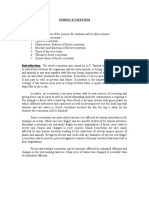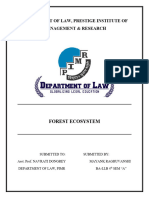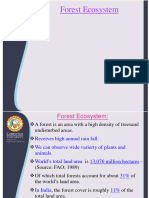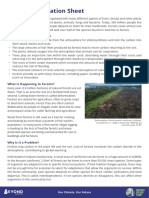0 ratings0% found this document useful (0 votes)
7 viewsChapter - 17
Forests are vital ecosystems that provide habitat for diverse plants and animals, produce oxygen, and maintain the water cycle. They offer numerous products such as wood, fruits, and medicinal plants, while also preventing floods and regulating climate. Conservation efforts are essential to protect forests from deforestation, which poses significant threats to the environment and biodiversity.
Uploaded by
shreysishahiCopyright
© © All Rights Reserved
Available Formats
Download as PPTX, PDF, TXT or read online on Scribd
0 ratings0% found this document useful (0 votes)
7 viewsChapter - 17
Forests are vital ecosystems that provide habitat for diverse plants and animals, produce oxygen, and maintain the water cycle. They offer numerous products such as wood, fruits, and medicinal plants, while also preventing floods and regulating climate. Conservation efforts are essential to protect forests from deforestation, which poses significant threats to the environment and biodiversity.
Uploaded by
shreysishahiCopyright
© © All Rights Reserved
Available Formats
Download as PPTX, PDF, TXT or read online on Scribd
You are on page 1/ 19
Chapter - 17
Forests : Our Lifeline
Presented by Shreysi Sahi
1. Forests:-
Forests is a natural habitat for many different
kinds of plants and animals. Forests provide
food and shelter for animals.
Some common animals found in a
forests are:- lion, tiger, elephant etc.
Some common types of plants found in
forests are:- trees like teak, bamboo, fog, saal,
seesham, neem, amla, etc… Forests also have
several kinds of shrubs, herbs, and grasses ,
climbers and creepers etc.
The forest is an ecosystem
An ecosystem is a self sufficient unit of living
things and non living thing enviornment
needing only the input of sunlight energy for
its functioning.
The forest is an ecosystem consisting of plants
animals decomposer and non living things
There is an interaction between living and non
living things
Composition of forests
The living organisms found in the forest are
plants, animals, decomposers and scavengers.
The non-living environment of the forest
provides nutrients, water and carbon dioxide
for the growth of the plants.
1. Plants
Green plants are living organisms also called
autotrophs as they produce food by photosynthesis
(by absorbing nutrients water from soil, CO2 from air
and sunlight as energy source). They provide food to
all living organisms which live in the forest. They are
called producers (of food).
2. Animals
Forests have many animals and they are called
consumers (of food). The animals which eat only
plants/their parts are called herbivores (herb eating)
whereas flesh-eating animals are called carnivores.
All animals are called heterotrophs because they
depend on other organisms for food.
3. Decomposers
Mostly these organisms are microorganisms like bacteria
and fungi. They feed on dead plants and animals and thus
are called saprotrophs. These organisms are also called
decomposers as they breakdown dead parts of plants and
dead bodies of animals into simple substances. They play a
very important role in sustaining the forests.
Those animals which eat dead
animals are called scavengers,
e.g. vultures, crows, jackals,
hyena, some insects (ants,
beetles, termites, woodlice,
maggots, millipedes and
earthworms), etc. Scavengers
are the cleaning agents of our
environment. But these are
not decomposers as they do
not breakdown complex dead
Importance of Forests
The forests provide us with a large number of
products. They also purify air and water
quality and maintain soil moisture and climate.
So, they are called lifeline
1. Forests Provide Many Useful Products
The various things which are obtained from the forests are called
forest products. Forests give us a large number of useful products.
Some of the important products which we get from the forests are
wood, honey, gum, sealing wax (or lac), catechu (kattha), fruits, oils,
spices, natural rubber, cork, dyes, medicinal plants and fodder for
cattle. Perhaps the most important product obtained from forests is
the wood (which is obtained by cutting down the forest trees). The
wood obtained from forests is used for a large number of purposes in
our day-to-day life.
2. Forests Maintain Balance between
Oxygen and Carbon Dioxide
Plants in the forest release oxygen during
photosynthesis. This provides all animals including
us with oxygen to breathe and helps to maintain the
ratio of oxygen to carbon dioxide in the atmosphere.
That is why, forests are called green lungs.
If the amount of carbon dioxide increases in the
atmosphere, it would result in an increase in earth’s
temperature. Plants in the forest intake carbon
dioxide from the atmosphere during photosynthesis.
Hence, they help to maintain the right amount of
carbon dioxide in the atmosphere.
3. Forests Maintain Water Cycle
The forest trees suck water from the soil through their roots and release
water vapour into the air through transpiration. This water vapour helps
in the formation of clouds and bring rain on the earth. Thus, forests
bring sufficient rainfall on the earth. In fact, about half the rain which
falls in forest areas comes from the transpiration of forest trees
themselves. In this way, forests help in maintaining a perfect water cycle
in nature and meet our freshwater requirements.
4. Forests Prevent Occurrence of Flood
The forest acts as a natural absorber of rainwater and allows it to seep.
It helps to maintain the water table throughout the year. Forests not
only help in controlling floods but also help to maintain the flow of
water in the streams so that we get a steady supply of water.
On the other hand, if trees are not present, rain hits the ground
directly and may flood the area around it. Heavy rain may also damage
the soil. Roots of trees normally bind the soil together, but in their
absence, the soil is washed away or eroded.
The different kinds of plants grow together in the forest making
different levels of layers and habitat for wild animals. In the absence of
plants/trees, the soil will not hold water which will cause flood and
erosion.
5. Forests Provide Habitat for Wildlife
The different types of vegetation present in a forest provide food and
shelter to animals, birds and insects which live in the forest. This
makes a food chain.
Food chain
Food chain can be defined as a sequence of
living organisms in which one organism feeds
on another.
A typical chain in grassland is: grass → deer →
lion
A typical food chain in a pond is: algae → small
fish → large fish
Flow of Energy in a Food Chain
The sun is the ultimate source of energy for
everything on the planet. Green plants or
producers are able to harness the energy of the
sun to make food. In a food Flow ener0y in food
chain chain, energy from plants (producers) is
passed on from one organism to another. From the
producers, the energy goes to primary consumers
(herbivores) and is then passed on to secondary
consumers (carnivores). Thus, producers are
always at the beginning of the food chain.
Dynamic Living Entity
By harbouring greater variety of plants, the forest
provides great opportunities of food and habitat for
the herbivores. Larger number of herbivores means
increased availability of food for a variety of
carnivores. The wide variety of animals helps the
forest to regenerate and grow. Decomposers help in
maintaining the supply of nutrients to the growing
plants in the forest. Therefore, the forest is a
dynamic living entity. There is a continuous
interaction between soil, water, air, plants and
animals in a forest.
6. Forests can Regenerate on their Own
The dead parts of trees and plants, dead animals and animal wastes
(like animal dung or droppings) keep on collecting on the forest floor.
Decomposers (fungi and bacteria) degrade them into simple organic
substances which are usable by plants in the form of humus. The
hummus makes the forest soil fertile by providing the nutrients. The
animals, birds of forests, wind and water disperse the seeds of trees
and plants on the forest soil. These seeds obtain nutrients from the
soil and germinate to form seedlings and ultimately grow to form the
forest vegetation.
Forest Conservation
Paper is made from wood pulp that is produced from the wood of
forest trees. So, to make paper, many trees have to be cut down from
the forests. If all of us keep on collecting old newspapers, magazines,
books, notebooks, etc., and send them to paper mills for recycling
through a junk dealer (kabaddi wala), we will be able to save many
forest trees from being cut down.
Some of the other ways to conserve forests are also given below:
Excessive cutting down of forest trees should not be allowed by the
government to conserve forests.
More trees should be planted in the forest in place of cut down trees to
conserve forests.
Paper products such as old newspapers, magazines, books, notebooks,
etc., should be recycled to conserve forests.
A large number of forest trees are being cut down every day to meet the
various demands of the increasing population. This is called
deforestation. Following are the consequence if forests disappear:
•Increase of the earth’s temperature If there are no trees and
plants, their will be no photosynthesis. So, no C02 of the
atmosphere will be used. This will increase the level of C02,
resulting in the increase of earth’s temperature.
•No food and shelter to wildlife In the absence of trees, plants
and animals will not get food and shelter. So, this will disrupt
the whole cycle of life and gradually life might disappear from
the land area of the earth.
•There will be more floods The trees plant roots help in holding
the soil during rains and also soil is able to hold water. In the
absence of trees, the soil will not hold water
which will cause floods.
•Deforestation endanger the environment The
continuous deforestation is threatening the
different form of life including human beings.
So, there is necessity to think and set to
conserve forests. Natural calamities like
floods, cyclones, hail forms are more in the
absence of trees and forest. People become
homeless when such disaster occurs.
You might also like
- 07 Conservation of Plants and Animals BiodiversityNo ratings yet07 Conservation of Plants and Animals Biodiversity10 pages
- Pipeline Associated Watercourse Crossings, 3rd EditionNo ratings yetPipeline Associated Watercourse Crossings, 3rd Edition202 pages
- Forest: Our Lifeline: by Abishek Thiyagarajan100% (1)Forest: Our Lifeline: by Abishek Thiyagarajan10 pages
- Important Question Class 7 Science Chapter 12No ratings yetImportant Question Class 7 Science Chapter 125 pages
- University of Eastern Philippines: Uep - Edu.ph EmailNo ratings yetUniversity of Eastern Philippines: Uep - Edu.ph Email3 pages
- Environmental Science and Engineering SCHX1001 Course MaterialNo ratings yetEnvironmental Science and Engineering SCHX1001 Course Material41 pages
- Energy Pyramids Educational Presentation in Organic Lined StyleNo ratings yetEnergy Pyramids Educational Presentation in Organic Lined Style26 pages
- Forests: Our Life Line: Biology ActivityNo ratings yetForests: Our Life Line: Biology Activity10 pages
- STF1023 LU1a BasicConceptofEcology 18.9.18 PDFNo ratings yetSTF1023 LU1a BasicConceptofEcology 18.9.18 PDF42 pages
- Modelando La Calidad Del Hábitat para El Pecarí de Collar en Una Reserva de Biosfera de México100% (1)Modelando La Calidad Del Hábitat para El Pecarí de Collar en Una Reserva de Biosfera de México16 pages
- Environmental Studies - AECC-Environment-Studies PDF50% (6)Environmental Studies - AECC-Environment-Studies PDF1 page
- Ecosystems: Key Vocabulary 5 Grade Team TimeNo ratings yetEcosystems: Key Vocabulary 5 Grade Team Time30 pages
- LENGKAP - 6. Kurniawan Et. Al. 2020 Ecology and Colour Variation of Oreophryne MonticolaNo ratings yetLENGKAP - 6. Kurniawan Et. Al. 2020 Ecology and Colour Variation of Oreophryne Monticola11 pages
- Science 4: Second - Quarter Written Test No. 3No ratings yetScience 4: Second - Quarter Written Test No. 37 pages
- Summer Program at The CFBISD Outdoor Learning CenterNo ratings yetSummer Program at The CFBISD Outdoor Learning Center1 page
- Alley Cropping: Conservation Practice Job Sheet 311No ratings yetAlley Cropping: Conservation Practice Job Sheet 3112 pages
- DLP G-IV To Describe The Effects of The Environment On The Life Cycle of Organisms With 80% Accuracy. S4LT-IIg-h-14No ratings yetDLP G-IV To Describe The Effects of The Environment On The Life Cycle of Organisms With 80% Accuracy. S4LT-IIg-h-142 pages
- Sudan Post Conflict Envirnment AssessmentNo ratings yetSudan Post Conflict Envirnment Assessment358 pages
- 07 Conservation of Plants and Animals Biodiversity07 Conservation of Plants and Animals Biodiversity
- Pipeline Associated Watercourse Crossings, 3rd EditionPipeline Associated Watercourse Crossings, 3rd Edition
- University of Eastern Philippines: Uep - Edu.ph EmailUniversity of Eastern Philippines: Uep - Edu.ph Email
- Environmental Science and Engineering SCHX1001 Course MaterialEnvironmental Science and Engineering SCHX1001 Course Material
- Energy Pyramids Educational Presentation in Organic Lined StyleEnergy Pyramids Educational Presentation in Organic Lined Style
- Modelando La Calidad Del Hábitat para El Pecarí de Collar en Una Reserva de Biosfera de MéxicoModelando La Calidad Del Hábitat para El Pecarí de Collar en Una Reserva de Biosfera de México
- Environmental Studies - AECC-Environment-Studies PDFEnvironmental Studies - AECC-Environment-Studies PDF
- LENGKAP - 6. Kurniawan Et. Al. 2020 Ecology and Colour Variation of Oreophryne MonticolaLENGKAP - 6. Kurniawan Et. Al. 2020 Ecology and Colour Variation of Oreophryne Monticola
- Summer Program at The CFBISD Outdoor Learning CenterSummer Program at The CFBISD Outdoor Learning Center
- Alley Cropping: Conservation Practice Job Sheet 311Alley Cropping: Conservation Practice Job Sheet 311
- DLP G-IV To Describe The Effects of The Environment On The Life Cycle of Organisms With 80% Accuracy. S4LT-IIg-h-14DLP G-IV To Describe The Effects of The Environment On The Life Cycle of Organisms With 80% Accuracy. S4LT-IIg-h-14

























































































